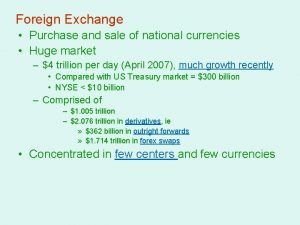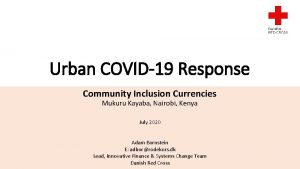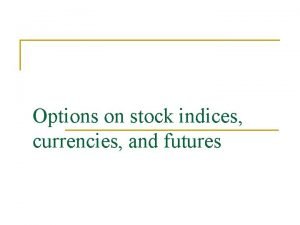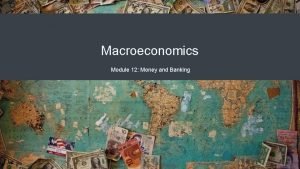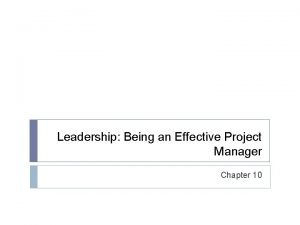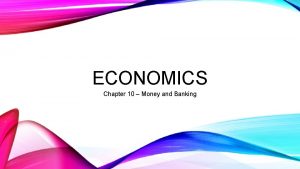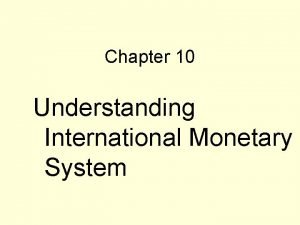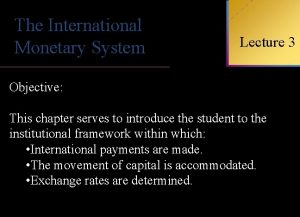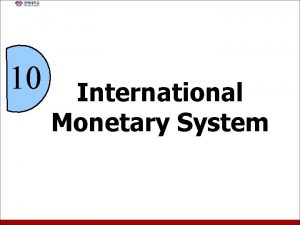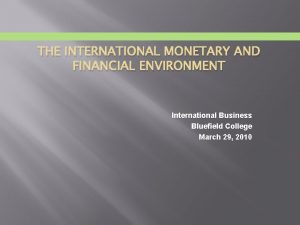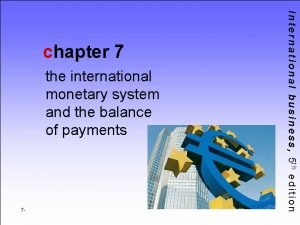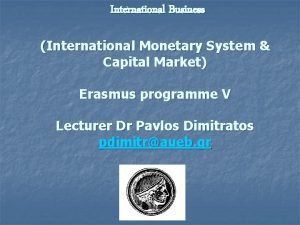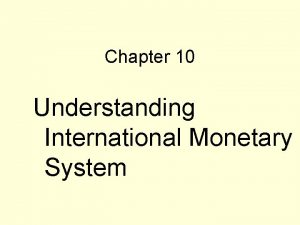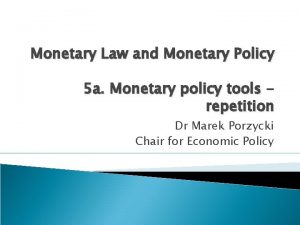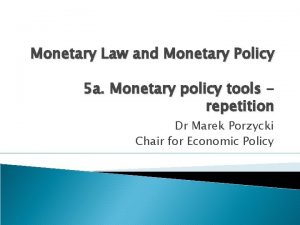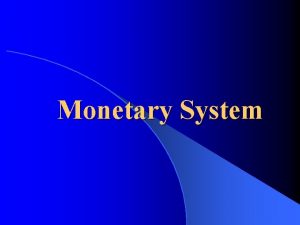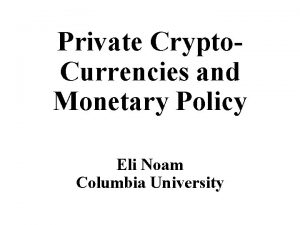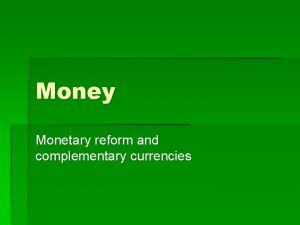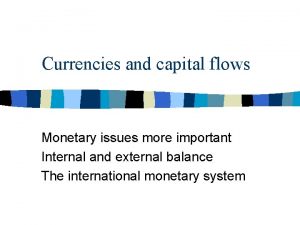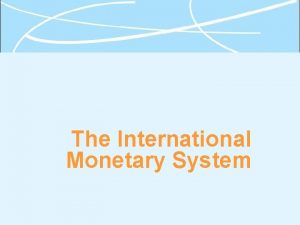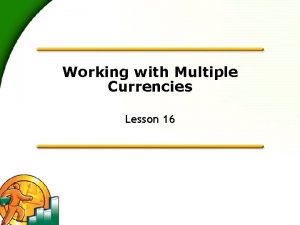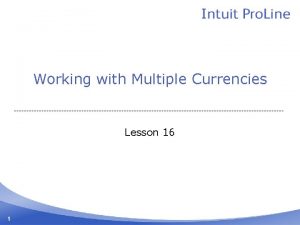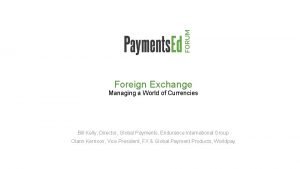Managing multiple international currencies in the international monetary





















- Slides: 21

Managing multiple international currencies in the international monetary system: reflections from the experience from 1950 -2000 Catherine R. Schenk, University of Glasgow, Scotland https: //upier. eu/ Uses of the Past in International Economic Relations

Are multiple currencies a source of risk? • Triffin Paradox: national currency as an international currency, requires deficit and undermines exchange rate stability: persists beyond pegged exchange rate regime • Sensitivity to US economic policy: asymmetry, spillover effects • Tipping point risk – massive switch collapses the international monetary system Both sterling and dollar weak in 1960 s: fear of tipping point for both Main policy response is SDR in 1960 s, call to enhance SDR in 2010 International Liquidity “a fashionable conversation piece of the economists’ union”: JK Galbraith to JFK (1963)

Functions of International Currencies • Reserves: $ stable at c. 63 -64% • FX/Money Market/Debt Markets: more diversified ($=44% FX turnover, 43% Cross-border payments) • Invoice, Unit of Account: $ for commodities, Euro intra-European trade, increasing share of RMB for Chinese trade • Portfolio diversification (ECB sold € 500 m for RMB June 2017 <1%) • RMB still only 1% identified reserves, 2% FX turnover • Variety in reserves preference (related to trade, debt, anchor)

Multiple currency system is the norm? • Sterling in Gold Standard: 1870 -1914 (40 years) • Sterling – Dollar – Sterling 1919 -39 (20 years) • Sterling decline: Dollar Rise 1945 -70 (25 years) • Dollar 1970 -90 (failure of Yen internationalisation, DM restricted) • Dollar, Euro 1999 – • Future: Dollar losing share, or other currencies jockeying for position while dollar holds its place? RMB? Euro? SDR?

Shares of Reserves Q 12015 70, 00 Share of Unallocated Reserves Q 12015 60, 00 50, 00 10, 62 40, 00 30, 00 66, 04 20, 00 10, 00 Emerging and Developing Advanced 0, 00 Shares of U. S. Shares of euros Shares of dollars Japanese yen pounds sterling Shares of Australian dollars Emerging and Developing Advanced Shares of Canadian dollars Shares of Swiss. Shares of other francs currencies

Non-Dollar Reserves Share Q 12015 25, 00 20, 00 15, 00 10, 00 5, 00 0, 00 Shares of euros Shares of Japanese yen Shares of pounds sterling Shares of Australian dollars Shares of Canadian dollars Emerging and Developing Advanced Shares of Swiss francs Shares of other currencies

4, 00 1, 00 0, 00 1995 1998 Q 2 1999 2000 Q 3 2000 Q 1 2001 Q 4 2001 Q 2 2003 Q 3 2003 Q 1 2004 Q 4 2004 Q 2 2005 2006 Q 3 2006 Q 1 2007 Q 4 2007 Q 2 2008 2009 Q 3 2009 Q 1 2010 Q 4 2010 Q 2 2011 2012 Q 3 2012 Q 1 2013 Q 4 2013 Q 2 2014 2015 Q 3 2015 1999 Q 4 1999 Q 3 2000 Q 2 2001 Q 1 2002 2003 Q 4 2003 Q 3 2004 Q 2 2005 Q 1 2006 2007 Q 4 2007 Q 3 2008 Q 2 2009 Q 1 2010 2011 Q 4 2011 Q 3 2012 Q 2 2013 Q 1 2014 Share of Sterling in Official Reserves Remember valuation effects: denominated in USD 7, 00 6, 00 5, 00 Advanced Economies 3, 00 Emerging and Developing Economies 2, 00 World Share of Dollar in Official Reserves 90, 00 80, 00 70, 00 60, 00 50, 00 Advanced Economies 40, 00 30, 00 Emerging and Developing Economies World 20, 00 10, 00

Managing the Decline of Sterling • Triffin Dilemma (1960) and fear of run on US drives search for cooperation • Central bank cooperation propped up the system • General Agreements to Borrow (1961: IMF, G 10) • Gold pool (1961 -1968) • Swaps (lines of credit) • Group Arrangements (lines of credit) • Urgency and Cooperation intensified by weakness of US Dollar

0, 0 1982 1981 1980 1979 1978 1977 1976 1975 1974 1973 1972 1971 1970 1969 1968 1967 1966 1965 1964 1963 1962 1961 1960 1959 1958 1957 1956 1955 1954 1953 1952 1951 1950 Percent Currencies Used as World Reserves 100, 0 90, 0 80, 0 70, 0 60, 0 Sterling 50, 0 US$ 40, 0 Other 30, 0 20, 0 10, 0

Pressures for Transition • Declining share of trade and debt in sterling • Perceived frailty of sterling exchange rate • UK policy focus turning to EEC BUT • Dollar’s value also becoming frail (particularly after sterling devaluation in Nov. 1967) • Danger of tipping point from diversification of reserves

Australia's Commitment to Sterling (%) 100 90 80 70 percent 60 Reserves Debt 50 Trade Sales to Banks 40 30 20 10 0 1961 1962 1963 1964 1965 1966 1967 1968 1969 1970 1971 1972 1973 1974 1975 1976 1977 1978 1979 1980 Source: C. R. Schenk and J. Singleton, ‘The shift from sterling to the dollar 1965 -76: evidence from Australia and New Zealand’, Economic History Review, 68(4), 2015

Sterling Group Arrangements 1961 -1977 Key example of Central Bank cooperation: G 10 Sterling was viewed as key line of defense for the dollar • $904 m in 1961 • $250 m in 1963 • $1 b in September 1964, $3 billion in November 1964 (equiv. to $37. 7 billion in 1997; IMF/BIS/World Bank/swaps Mexico rescue in 1997 $40 b) • $1 b 1966; • $1 b 1967 (sterling devalued, end of gold pool) • $2 b 1968 (equiv $38 b today) • $2 b 1977 (+sale of $/Yen/Sw. Fr bonds) • Terms tightened from 1968: link to IMF Stand-by in 1977

Sterling Agreements 1968: negotiated bilaterally with 34 countries Territory MSP (%) East Caribbean Currency Authority 100 Zambia 65 Gambia 100 Nigeria 60 Hong Kong* 99 Jamaica 57 Barbados 97 Ireland 55 Mauritius 95 Uganda 51 British Honduras 90 Cyprus 50 Bahamas 80 Dubai 50 Bermuda 80 Iceland 45 Ceylon 80 Australia* 40 (47) Ghana 80 Malaysia* 40 (45) Guyana 80 Pakistan 40 Malawi 80 Singapore* 40 Trinidad 80 Jordan 25 Malta 75 Tanzania 25 Bahrain 70 Kuwait* 25 (54) New Zealand* 70 Libya 18 (50) Sierra Leone 70 India 13

Share of Sterling in Reserves (Percent) Sterling Agreement Countries All Countries 1968 57. 9 20 1969 56. 1 17. 5 1970 53. 7 5. 2 1971 61. 6 4. 5 1972 54. 5 4. 7 There were two rounds of compensation under the guarantee October 1972 (costing £ 58 million) October 1973 (costing £ 100 million)

Not a Tipping Point 4, 5 64 4 62 3, 5 60 3 58 2, 5 56 2 54 1, 5 52 1 50 0, 5 48 0 Percent £ million Sterling Agreements Countries Sterling Reserves 1968 -73 46 1968 1969 II 1969 1970 II 1970 1971 II 1971 1972 II 1972 1973 II III IV III IV Source: Schenk, The Decline of Sterling: managing the retreat of an international currency (2010) Sterling LHS Sterling % RHS

SDR – Triumph of Compromise over Clarity • Prolonged and acrimonious debate over a range of schemes from 1960 (Per Jacobsson) • • Too much liquidity or too little? Europe vs USA Replace the dollar or supplement it? Link to gold or not? Form of credit or reserve asset? (repayable? Unconditional? ) • 1967: need something to present at Rio Summit September 1967 • last minute fudge August 1967 • sterling devalued, gold pool collapses • March 1968 Stockholm meeting to finalise amendment to Articles of Agreement and details of SDR: Debre of France abstains • First tentative issue 1970 -72

End of the Bretton Woods System • System began to collapse after Sterling devaluation in 1967 • Run on the dollar and collapse of Gold Pool in March 1968 • September 1968 Sterling holders promise to retain share of sterling reserves • US inflation pushes Europe to convert dollars into gold in 1971 • Nixon closed the Gold Window in August 1971 • Smithsonian Agreement not credible

1970 s: Transitional phase • Cooperation and Coordination: • Swaps and Group Arrangements continue (CB cooperation) • Efforts to reform the international monetary system come to little (SDR, Substitution Account, imbalances trigger, NIEO) • Low point for IMF (greater importance for G 10 and then extension to C 20): diffusion • Launch of G-summitry 1975 • Reform of SDR: eliminate gold link, more competitive interest rate, basket of currencies smaller

1980 s-1990 s: Continued Effort to Manage Currencies • 1978 US dollar crisis: Coordinated dollar defense, Carter Bonds (weak effects) • Volcker (1979): supported by G 10 central banks at BIS • G-summits: Plaza (1985) and Louvre (1987) • Limited effect of Exchange Market Intervention • Longer term damage to Japan • Major failure of Coordination • After Volcker, CB independence and rules based policy focused on credibility for low inflation • End of FX intervention by US in 1995 • EME crises in 1990 s spread floating rates and inflation targeting but also return of reserves accumulation

2000 s – the era of the RMB? • Resurgence in $ use after 2008 (RMB re-pegged) despite weaknesses in US economy • 2010: PBo. C call for mobilisation of SDR, reduce reliance on USD • Internationalisation of RMB as part of China’s outward-looking economic strategy (AIIB, OBOR, Cross-Border Interbank Payment System, join SDR) • Internationalisation faltering? • trade settlement ranking 5 th (2015) to 7 th (May 2017): 76% is Hong Kong • Symmetric exchange rate risk reduced demand for RMB assets (Aug 2015) • Difficulties generating bond market

Conclusions/Speculations • We’ve lived with multiple international currencies for a long time • Dollar is most prominent – but dominance varies according to purpose • SDR mobilisation as a way to avoid tipping point? • SDR not a currency now, no market (limited new bond issues 2016) • Easily replicated for diversifying risk, less liquid: needs other advantage • Future: more diversified system? • Unlikely: Euro and RMB have institutional flaws, US appetite for debt not likely to decline • Likely: US retreats from globalisation, OBOR increases Chinese economic sphere of influence, Euro moves to fiscal convergence ? Impact of higher inflation, shrinking Central Bank balance sheets in 2020 s?
 Most traded currencies
Most traded currencies Power currencies in conflict
Power currencies in conflict Community inclusion currencies
Community inclusion currencies Put call parity
Put call parity What is fiat
What is fiat Inspiration related currencies
Inspiration related currencies What is a fiat currency
What is a fiat currency Convertible currencies
Convertible currencies International monetary system
International monetary system International monetary fund apush
International monetary fund apush Objectives of international monetary system
Objectives of international monetary system International monetary and financial environment
International monetary and financial environment International monetary and financial environment
International monetary and financial environment International monetary system
International monetary system International monetary fund
International monetary fund International monetary system
International monetary system International monetary fund
International monetary fund Managing multiple projects objectives and deadlines
Managing multiple projects objectives and deadlines Multiple baseline across settings
Multiple baseline across settings Multiple instruction single data
Multiple instruction single data Hình ảnh bộ gõ cơ thể búng tay
Hình ảnh bộ gõ cơ thể búng tay
